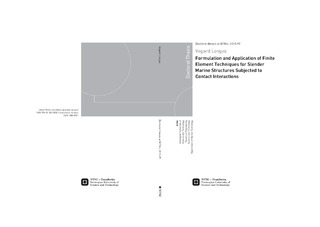Formulation and Application of Finite Element techniques for Slender Marine Structures Subjected to Contact Interactions
Doctoral thesis
Permanent lenke
http://hdl.handle.net/11250/2358726Utgivelsesdato
2015Metadata
Vis full innførselSamlinger
- Institutt for marin teknikk [3397]
Sammendrag
The main purpose of this work is to formulate and apply new computational strategies
for two contact-governed problems where existing finite element software suffer from
poor efficiency and lack of robustness. The first problem is concerned with trawl board
pull-over interaction of subsea pipelines while the second deals with reeling analysis of
history-dependent flexible pipes.
Previous numerical models for trawl-pipe interaction based on simplified geometry
modeling has struggled with contact-related convergence problems. A contact element
with a continuous description of the trawl board contact geometry and the pipe geometry
was therefore developed. The assumption of a rigid contact geometry for the trawl board
and the use of line-line and line-point contact kinematics resulted in good numerical efficiency
properties. The ability to predict the pull-over responses depends heavily on the
modeling of the trawl board hydrodynamic loads. A fairly advanced six degree of freedom
load model with precomputed hydrodynamic coefficients was therefore established.
An extensive simulation work was carried out to validate the trawl-pipe computational
strategy and to identify sensitive model parameters. Regarding the former, the proposed
numerical model was demonstrated to predict pull-over load impulses within a 10% margin
of model test measurements and was thus concluded to be capable of describing the
relevant effects of the pull-over. The sensitivity study revealed that the interaction behavior
was greatly influenced by the board-pipe friction coefficient, the tension level in
the wire between board and trawl net, the towing line drag properties and the direction
of over-trawling. Due to the sensitivity of the input parameters, it was concluded that a
proper validation against experimental tests is necessary for future work of similar kind.
Further studies should aim to quantify the degree of non-conservatism present for nonperpendicular
crossings and attempt to improve current design load recommendations by
including more model parameters.
Reeling operations with history-dependent material behavior and extensive contact
interactions along the material transport route are often not feasible to simulate with conventional
finite element software. This relates to contact-related convergence problems
and the need for long meshes with small and equal-sized elements giving poor numerical
efficiency. These issues were successfully solved by developing a Lagrangian-Eulerian
beam formulation that enabled for a virtually fixed mesh in space. The proposed formulation
was subjected to various benchmark tests where it was demonstrated to provide
similar accuracy as the conventional Lagrangian method.
In recent years, subsea contractors have experienced torsional failures in spoolbasevessel
load-out operations of flexible pipes. An idealized finite element model was therefore
established to gain insight into such operations and to identify the mechanisms responsible
for the generated torque. Torsional failures were identified for three different
mechanisms and strategies to avoid them were proposed. A comparison study against a
physical load-out operation should be conducted in future work to quantify the ability to
predict the torque and to reveal possible model deficiencies.
Består av
Paper 1: Longva, Vegard; Sævik, Svein. A Lagrangian–Eulerian formulation for reeling analysis of history-dependent multilayered beams. Computers & structures 2015 ;Volum 146. s. 44-58 http://dx.doi.org/10.1016/j.compstruc.2014.09.002Paper 2: Longva, Vegard; Sævik, Svein; Levold, Erik; Ilstad, Håvar. Dynamic simulation of subsea pipeline and trawl board pull-over interaction. Marine Structures 2013 ;Volum 34. s. 156-184 http://dx.doi.org/10.1016/j.marstruc.2013.09.004
Paper 3: Longva, Vegard; Sævik, Svein. A penalty-based contact element for pipe and 3D rigid body interaction. Engineering structures 2013 ;Volum 56. s. 1580-1592 http://dx.doi.org/10.1016/j.engstruct.2013.07.025
Paper 4: Longva and S. Sævik. On prediction of torque in flexible pipe reeling operations using a Lagrangian-Eulerian FE framework. © 2016. This manuscript version is made available under the CC-BY-NC-ND 4.0 license http://creativecommons.org/licenses/by-nc-nd/4.0/ published in Marine Structures Volume 46, March 2016, Pages 229–254 http://dx.doi.org/10.1016/j.marstruc.2016.01.004
